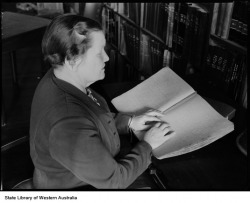Braille: Facilitating the Lives of the Blind
"Braille can be very helpful in creating more independence in the lives of blind people. If our college textbooks or other materials we need to educate ourselves are available in braille we are better able to read them and get our studying done without enlisting the aid of someone else to spend hours reading to us."
-Chris Coulter [3]
-Chris Coulter [3]
"Reading and Writing Braille"
<http://innopac.slwa.wa.gov.au/record=b2489822>
(Jan 9, 2010)
<http://innopac.slwa.wa.gov.au/record=b2489822>
(Jan 9, 2010)
Braille improved communication for the blind by giving them a quick and efficient way to read and write [2]. Since writing was the main method of communication at the time, being able to read and write was a big deal. Using Braille, the blind could read more books and even write books themselves [1]. They could write letters much more easily using a slate and stylus, and they could read letters on their own, instead of having a sighted person read them out loud [1]. By learning braille, they had access too much more independence [3]. Even today, braille is still a very important tool for communication [2]. For example, braille is used in public places such as on elevator buttons or on street corners [3]. It is still used for reading and writing, not only on paper, but also with computers.
[4] Above is a page from These Happy Golden Years, from the Laura Ingalls Wilder Series. In this part of the story, Mary (Laura's blind sister) is visiting from her school for the blind. She talks about how easily she can read with braille.
1. Carolyn Meyer "A New Method: The Story of Louis Braille" <http://louisbrailleschool.org/resources/louis- braille/> (Dec 8, 2009)
2. Berthold Lowenfeld, The Changing Status of the Blind, (Springfield, Il: Thomas, 1975)
3. Chris Coulter (blind since birth) interview by Rose Hinson and Sayaka Yamamoto (Dec 9, 2009)
4. Wilder, Laura Ingalls. These Happy Golden Years. (New York: Harper Trophy, 1943)
2. Berthold Lowenfeld, The Changing Status of the Blind, (Springfield, Il: Thomas, 1975)
3. Chris Coulter (blind since birth) interview by Rose Hinson and Sayaka Yamamoto (Dec 9, 2009)
4. Wilder, Laura Ingalls. These Happy Golden Years. (New York: Harper Trophy, 1943)


